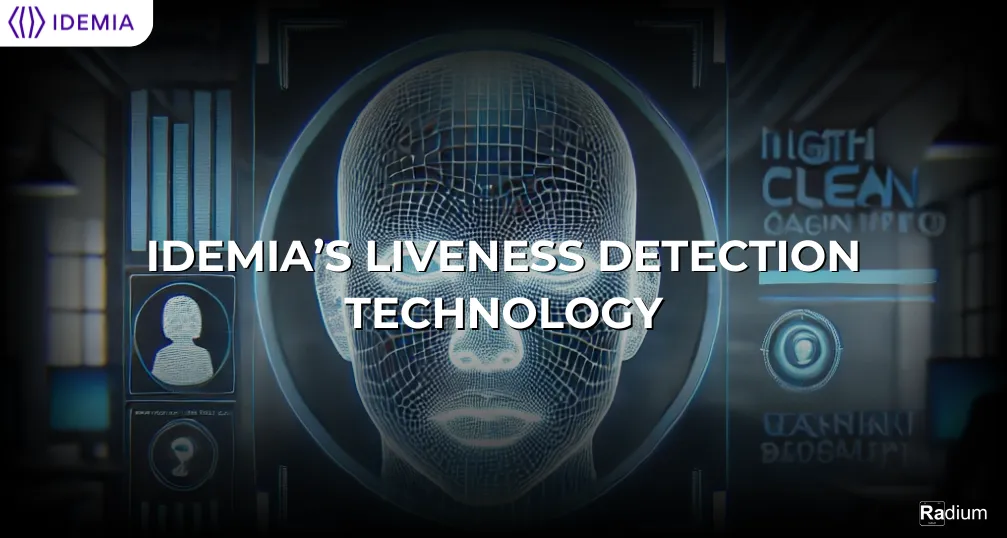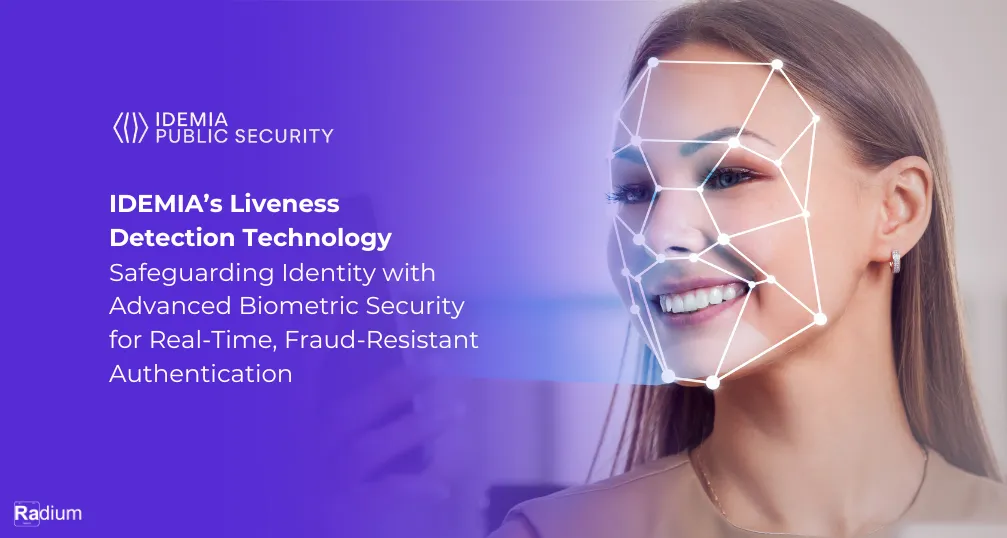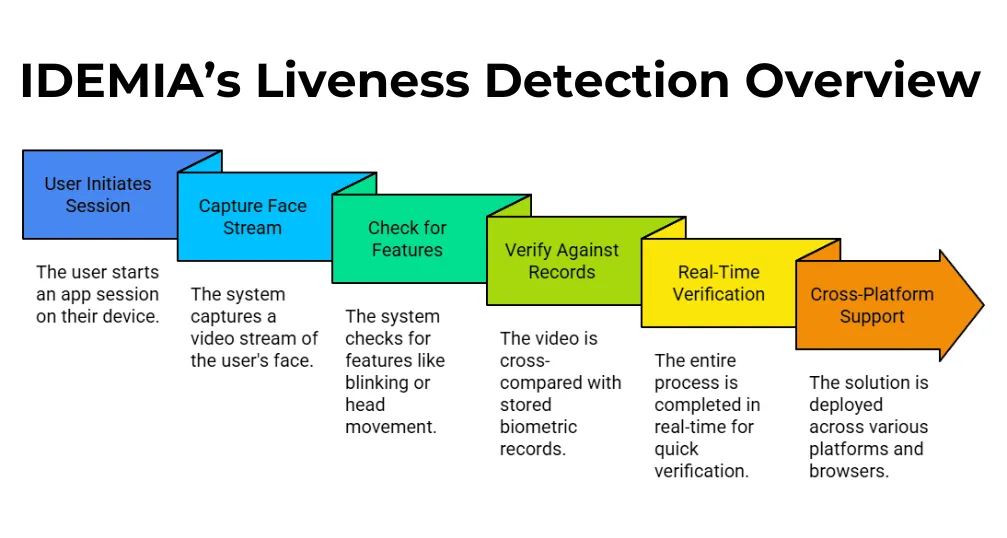
Since the world is growing more digital day by day, secure and seamless online identity validation is the moment of need. Identity fraud, cyber-attacks, and identity theft keep unfolding and so will the technologies securing us from these threats. Biometrics have proven to be one of the most effective methods of user authentication and defense against identity fraud, particularly liveness detection technology.
IDEMIA, a global leader in Augmented Identity, has led the way with innovative biometric solutions, and their liveness detection technology has led the way. With the success of achieving the highest rank in the Department of Homeland Security's (DHS) Remote Identity Validation Technology Demonstration (RIVTD), IDEMIA has proved its commitment to the creation of biometrics that not only provide accuracy but also fairness, security, and compliance with the highest ethical standards. In this blog, we are talking about IDEMIA's liveness detection technology, how it was identified during the DHS test, and how it contributes to safer digital onboarding, secure identity verification, and preventing fraud.
In an age where transactions and communications online are at the forefront of commerce and daily life, security systems have never had a more crucial function. Passwords are no longer sufficient to safeguard sensitive information. Cyberthieves have found ways to go around conventional security systems, and never before has it been easier to steal identities.
Biometric authentication, based on distinctive physiological and behavioral characteristics, has become the answer to these security issues. Facial recognition, fingerprint identification, and iris scanning are most widely employed among all types of biometric authentication. Of these, liveness detection technology has been the focus.
Liveness detection, in essence, verifies that a biometric sample being recorded is from a live person, not a spoofed image, video, or mask. With the growing cunning of fraudsters, liveness detection has emerged as an important aspect in combating identity theft and account takeover.

Liveness detection is a technique utilized in biometric systems for the purpose of verification that the sample being provided is of an authentic, live human, not an image, video, or artificial model. It is very essential in the process of verification of a user and the protection of systems against many kinds of fraud tactics, including spoofing attacks. Spoofing is the process of impersonating a legitimate user by presenting synthetic biometric data in the shape of images, videos, or masks to avoid biometric verification systems.
IDEMIA's liveness detection technology can be of assistance in counteracting the risk that is brought about by such spoofing attacks. Solutions provided by companies are able to detect any presentation attacks, thus introducing an additional level of security into remote identity verification processes. This means that fraudsters cannot falsify biometric data to acquire unauthorized access to systems or information.
Department of Homeland Security Remote Identity Validation Technology Demonstration (RIVTD) is a visibility test that tests remote identity verification technologies on the basis of their effectiveness and security. The test evaluates the ability of biometric systems to withstand spoofing attacks and comply with regulation requirements when used live. RIVTD consists of different tracks, each highlighting a unique face of identity verification. For example, one of the tracks assesses ID document authentication, and another looks into biometric selfie matching.
During the 2025 RIVTD test, IDEMIA took Track 3: Liveness Detection with the top mark for its superior performance in spoofing attacks resistance across different demographic attributes such as gender, race, and complexion. The triumph demonstrates IDEMIA's dedication to offering highly secure and unbiased biometric solutions that function equally well across different populations.
The RIVTD test scenario was stringent, incorporating thousands of volunteers and a large variety of presentation attack instruments (PAIs) that were made to deceive the system. The challenge notwithstanding, IDEMIA's liveness detection technology correctly identified all attempts at spoofing the system with a remarkable Attack Presentation Classification Error Rate (APCER) of 0%. This translates to the fact that no attempted fraud was able to evade the liveness detection system.
One of the most significant findings from IDEMIA's number-one-ranked RIVTD test performance is the solution's impartiality in its liveness detection. The solution identified attempts to spoof all across demographics and afforded equitable and balanced treatment for subjects of varying gender, race, and skin types. This is a significant improvement for the biometrics industry, which has contended with bias and demographic-dependent performance issues for years.
Equity is now becoming an utmost critical issue in biometric technology, that is, with regard to global regulation and the growing demand for ethical solutions.IDEMIA's solution being equitable corresponds to its heritage of creating secure and equitable biometric systems. According to IDEMIA Chief Technology Officer Vincent Bouatou, it's not just a moral and ethical responsibility but also a law that fairness is becoming in today's fast-changing landscape of regulation.
By addressing these problems directly, IDEMIA is creating a new standard for the biometrics industry in a manner in which identity verification technology becomes reliable and available to all, regardless of demographic profile.
Apart from its performance on the RIVTD test, IDEMIA's liveness detection solution also achieved first-rate certifications, including Level 1 and Level 2 certification by iBeta, a leading independent third-party testing laboratory. The certification is performed according to the ISO/IEC 30107-3 standards, an internationally recognized standard for biometric liveness detection.
The testing process, conducted during December 2019, replicated real-world use cases where the biometric information of real users was volunteered for being captured and spoofing attacking. The spoofs included photos, videos, and even advance-level artifacts like plastic masks, latex, and silicone. The system from IDEMIA defeated all presentation attacks notwithstanding these and had an APCER of 0%.
With the revolution in the digital world in this era, organizations are under immense pressure to offer frictionless, secure, and convenient onboarding experiences. Offboarding remotely enables customers to use services like banking, telephony, and public services without ever entering an office. This is made possible through smartphones with biometric functions and pervasive internet access.
But remote onboarding also entails significant threats, mainly from fraudsters trying to evade biometric authentication. Presentation attack detection (PAD) assumes center stage for companies to ensure their protection from fraud and adhering to robust Anti-Money Laundering (AML) and Counter-Terrorism Financing (CTF) regulations. Failure to comply with these rules can result in huge penalties and loss of reputation.
With the integration of IDEMIA's liveness detection solution, businesses can minimize the risk of fraud during remote onboarding to a significant extent. The solution prevents the authentication process from being completed by imposter, fake users, as demanded to counter the growing identity fraud threat.
IDEMIA's liveness detection solution is incorporated in its SmartBio and WebBioServer SDKs, allowing companies to have strong products for delivering multi-channel identity verification. The SDKs can be used by customers to deploy the liveness detection technology via Android and iOS applications or web browsers, giving users mobility on various platforms.
Here’s a closer look at how IDEMIA’s technology works:

Liveness Detection Process:
Step 1: The user initiates an app session either on the app or browser.
Step 2: The system captures a stream of the user's face to check his/her liveness.
Step 3: The system checks for definite features on the video, like blinking or head movement, to ensure that the user is not dead.
Step 4: The system also verifies the video and cross-compares the same with reference biometric records to compare the user identity with the stored identities.
Real-Time Verification: The whole process is executed in real-time, providing users with an unbroken and fast experience with the highest possible level of security.
Cross-Platform Support: IDEMIA solutions are mobile-enabled and cross-browser, enabling companies to deploy them on desktop browsers with ease as well as on mobile platforms in bulk.
Applications and Use Cases
Remote Digital Onboarding: IDEMIA's liveness technology is applied extensively in remote digital onboarding procedures of banks, mobile network operators, and other organizations. It protects such procedures from fraud as well as from anti-money laundering (AML) and counter-terrorism financing (CTF) obligations.
Identity Verification: The technology is embedded in multiple identity verification solutions, such as IDEMIA's SmartBio® and WebBioServer SDKs, which offer multi-channel identity verification solutions for Android and iOS mobile applications, as well as web browsers.
With improving digital identity technologies, so is the demand for sophisticated security products such as liveness detection. As data protection, security, and fraud protection concerns grow by the day, it is only right that enterprises embrace technologies providing not just great accuracy but transparency and fairness too. IDEMIA's top ranking in RIVTD evaluation and its commitment to developing ethically justifiable biometric solutions are evidence of the company's leadership status in the sector.
In the years to come, the need for safe, fast, and equitable biometric authentication systems will only increase. As progressively tighter privacy and security measures are enforced worldwide, IDEMIA's liveness detection technology plays a vital part in responding to these demands.
Conclusion:
IDEMIA's cutting-edge liveness detection technology is the future of biometric authentication. The success of the company in the DHS RIVTD test and its iBeta certification reflects its commitment to providing secure, accurate, and fair biometric solutions. As the world continues to be redefined by digital transformation, businesses can count on IDEMIA to stay ahead of the game when it comes to changing security threats and offer their customers a seamless, secure, and fraud-proof identity verification experience.
In an age when cybersecurity matters the most, IDEMIA innovation is making biometric liveness detection rethink its future. Solutions offered by IDEMIA are changing the game in authenticating digital identity such that scammers have no business in the safe digital age.
IDEMIA's liveness detection applies facial analysis to authenticate the presence of an actual person. It provides active (user-driven movements such as blinking or head movement) and passive modes (facial feature analysis). The system identifies spoofing attempts by employing sophisticated algorithms and random challenges sometimes combined with identity verification for smooth authentication.
IDEMIA's liveness detection solution was Level 1 and Level 2 certified by iBeta, a third-party tester, against the ISO/IEC 30107-3 standard. The solution was put to the test in which it was subjected to enrollment biometric and biometric presentation attack simulations like silicone, latex, and plastic masks. The system was successful in blocking these attacks and recorded an Attack Presentation Classification Error Rate (APCER) of 0%.
Liveness detection is an addition to remote onboarding that confirms the person as genuine and not using impersonation through images or videos. It safeguards against fraud, enhances security, and speeds up the process through quick selfie or video authentication. It also assists companies in ensuring KYC compliance, reducing fraud, and earning trust from genuine customers.
Yes, IDEMIA's liveness detection solution is compatible with legacy infrastructures. Its Identity Proofing API-first, module-based platform provides legacy system and third-party source integration. The integration options are deploying the Biometric Capture SDK to capture faces and fingerprints in apps, the Global Identity Proofing Service (GIPS) to prove identities anywhere in the world, and Bioserver component to integrate biometrics. The tech utilizes AI to authenticate a video individual based on their ID and whether they are "live" in a move aimed at curbing spoof attacks through pre-recording or deep fakes.